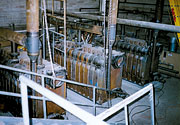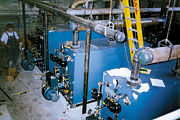
When the energy management coordinator, Bill McLeod, came on board about 11 years ago, he was particularly interested in looking at how the mechanical systems might be retooled in order to save some money. During his examinations, he found that not enough attention or money was being applied to the systems' maintenance and repair, and many systems were not operating in peak condition. This was particularly true where the boilers were concerned.
As it turned out, the existing firetube boilers needed a large amount of maintenance. Every year the district was shelling out between $50,000 and $100,000 for tube replacements, tube sheet repairs, and other boiler repairs. McLeod decided something needed to be done. In addition to wanting to save the money being spent on annual repairs, he wanted equipment that required less maintenance and was more efficient than the existing boilers.
He found his answer in cast iron boilers for both his steam and hot water applications. And instead of installing one or two large boilers per school, he prefers to have multiple smaller boilers installed. This arrangement, he says, reduces maintenance and lowers energy costs, which makes this engineer - and the school district - extremely happy.
Coming From The Outside
Eleven years ago, Bill McLeod was not only new to the Granite School District, he was new to the educational system in general. He had been a consulting mechanical engineer for 30 years prior to coming to the school district. During those years he designed a lot of mechanical and plumbing systems for new and existing schools, and it became obvious to him that schools often didn't take into account the life cycle replacement costs of mechanical systems. In addition, many school district personnel didn't understand mechanical systems and, as a result, didn't allocate adequate money for equipment replacement, upkeep, or maintenance."During my 30 years as a consulting engineer, most school districts I saw had terrible mechanical systems because not enough attention or money was being applied to their maintenance and repair. As a result, I decided to see what I could do to help one of the larger school districts in the state, so I came to work here at Granite as their mechanical engineer and energy management coordinator," says McLeod.
As McLeod started looking at the conditions of the older schools in the district, he noticed that the mechanical systems were in pretty bad shape. Numerous problems were reported with the boilers, which numbered approximately 243 (mostly firetube steam) in 90 schools and other district buildings. Many of those boilers were in need of repair.
Then an interesting thing happened. McLeod noticed that the oldest boiler in the district, which was installed in 1908, was a cast iron boiler. And it was still operating. "I thought that was really cool. Why the longevity of that son of a gun? I talked to some of our maintenance people and I asked how it had been, and they said they hadn't touched it. It had an old gravity-type burner, and it just had gone on forever. That was interesting," says McLeod.
Looking at that old cast iron boiler, McLeod thought maybe that was the direction to go. So a bid was put out in 1992 for the first school in the district to receive cast iron boilers. Sabol and Rice, also of Salt Lake City, was awarded the contract, and the first Weil-McLain cast iron boilers were installed in the Granite School District.
Cast Iron Easier To Install
No one was happier about Granite's choice of cast iron boilers than Steve Montgomery, sales engineer, Sabol and Rice. "Most engineers seem to be stuck on watertube boilers and firetube boilers, because they think they're more flexible. Engineers also have this misconception that cast iron is brittle and susceptible to cold shocking, which makes them crack. That's totally false," says Montgomery.Montgomery adds that cast iron boilers usually only go bad if they're filled with scale, then they will crack. "But scale will ruin every boiler. Cast iron is quite a good material to use for heating. Boilers heat and cool, and about the only thing that does that much heating and cooling in a day would probably be a car engine. And they make those out of cast iron, too," notes Montgomery.
McLeod indicated that initially the maintenance staff wasn't too excited about having cast iron boilers installed. He says that in recent years, some of the boiler maintenance personnel have said to him, "You know when you first started going in the direction of cast iron, we thought you were crazy. But now that we've got quite a number of them in the district, we've realized how much it's helped our maintenance problems, and we realize how much it's cut down on our outside repair costs." That positive reaction has been one of the highlights of this project, notes McLeod.
Another bonus is that cast iron boilers break down into sections, making it easier to take them into the basement in sections and then put them together down there. There's no need to cut openings into walls or dismantle parts of the building to bring in the boiler. Watertube and firetube boilers, although usually less expensive than cast iron, come in as a single piece, so they may be more difficult to get in the door. Many of the Granite schools have their existing boilers located in the basement, and the district was looking at tearing down walls and building them back up again if firetube or watertube boilers were installed.

Multiple Benefits
Once it was decided that cast iron was the way to go, the decision had to be made as to how large the boilers should be. Montgomery thought that it would be a good idea to install multiple smaller boilers, as they are less expensive than the huge boilers normally used by the district. In addition, multiple smaller boilers could save costs in the area of actual construction.McLeod definitely agreed, especially because of Environmental Air Quality's monitoring requirements. Smaller boilers reduce both federal and state monitoring demands, and the smaller boiler footprints would easily adapt to the existing available space.
Boiler size in the district is now usually standardized, based on the type of school, be it a retrofit project or new construction. An elementary school, depending on its size, usually has one boiler. Junior high schools receive two to three cast iron boilers that are less than 5 MBtu each. High schools usually require four to five cast iron boilers, also less than 5 MBtu each.
Wherever multiple boilers are installed in the district, it's been extremely advantageous to install sequencers on the boilers. "We start one boiler and run it up to its most efficient capacity, then if our load requires additional heat, we'll bring a second one on, then run it up until it's at its maximum or most efficient capacity, then bring the third one on and so on and so forth. That's worked extremely well for us," says McLeod.
Montgomery notes that one of the maintenance people who comes in at about 6 a.m. is particularly fascinated with the sequencing during the warm-up cycle. "He comes in when only one of the boilers is half-fired, which maintains the temperature. About a half hour before the school bell rings, he says he watches the four boilers, and the first one will go up to full fire, then the second one will modulate up to full fire, then the third one will modulate up to the full fire. Then the school bell rings and all the doors shut and all the kids go to class, and he says he just watches them go right back down. He says it's the neatest thing in the world."
Multiple boilers are also nice to have in case backup is needed. In the case of cast iron, it's possible to lose a section or a burner in a boiler, then the remaining boilers are used to get through the peak periods until a repair can be made. With one boiler, it becomes necessary to really hustle to get it back up and running in order to have adequate heat.
That also makes it nice from an efficiency standpoint, because it's only necessary to fire the boilers that are actually needed. McLeod notes that in one smaller junior high alone, there has been a $7,000 annual savings in the cost of gas because of the new cast iron boilers. That's pretty significant, considering all the schools in the district.
Standard Model, Standard Maintenance
It's been about ten years since the first cast iron boiler was installed in a Granite District school. As the district has the money, the boilers are being replaced in the other schools in the district as well. In some years as many as 25 boilers have been replaced with cast iron boilers. Newly built schools almost always have cast iron boilers specified as well.McLeod says he's tried to standardize the type of boiler as much as possible. Since it's always an open bid situation, there are some times when other manufacturers of cast iron boilers are chosen. At this point there are 70 identical Weil-McLain boilers (each under 5 MBtu) in the district. Since the cast iron sections are identical, it means that the maintenance staff has to stock only those sections.
Although, as McLeod notes, "I don't think we've had a section fail yet. The boilers themselves have been far more reliable than I thought they would be. I was concerned that we might end up going through several sections cracking, but honestly, the sections on these boilers appear to be as reliable as the old cast iron blocks in your automobile engines."
In schools with cast iron boilers, the costs of tube repairs have disappeared. In addition, it's relatively easy to do the annual boiler inspections on these boilers.
One maintenance person told Montgomery that he can check all five boilers in his school in the time it used to take him just to get the back plate off one of the old firetube boilers. "Once a year, all they have to do to maintain these boilers is pull off these little clean-out plates, which takes no time to do. They run a brush through them and if they're dirty inside, then they tag that burner because they know that burner is running rich or out of whack a little bit. If it's clean inside, they know it's running fine," says Montgomery.
The Granite School District has currently replaced about half its existing firetube boilers with cast iron boilers, and it plans to keep going until they've all been replaced. "We're getting rid of our problems as we're putting these new boilers in. The best gauge that I have of determining good or bad is the feedback from our maintenance people. That's the cool part, because initially they were giving me all kinds of flak, and now I get all kinds of appreciation. It means the district is going in the right direction," says McLeod. ES

